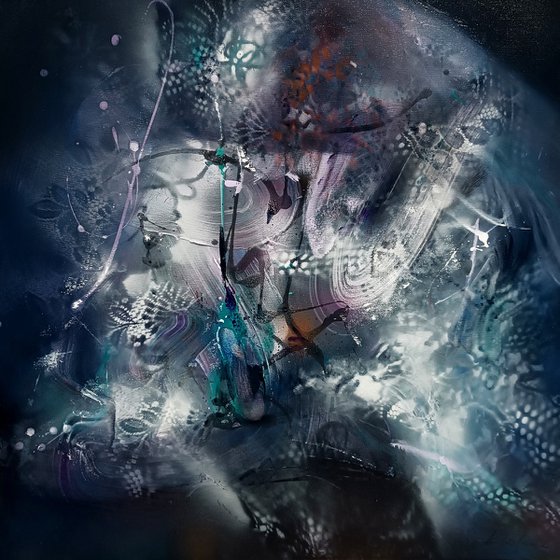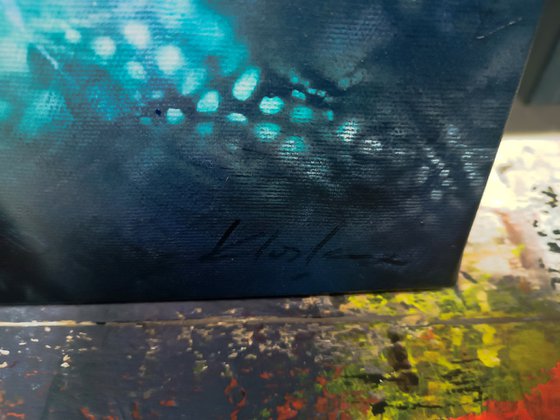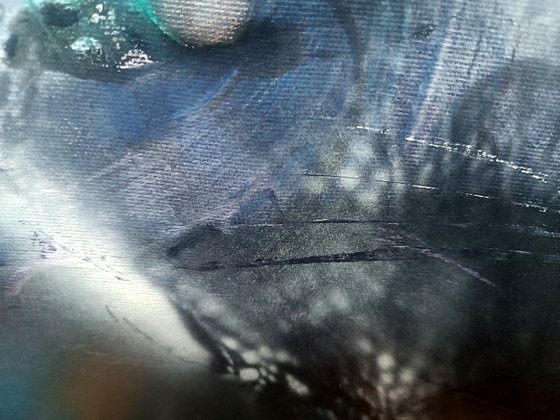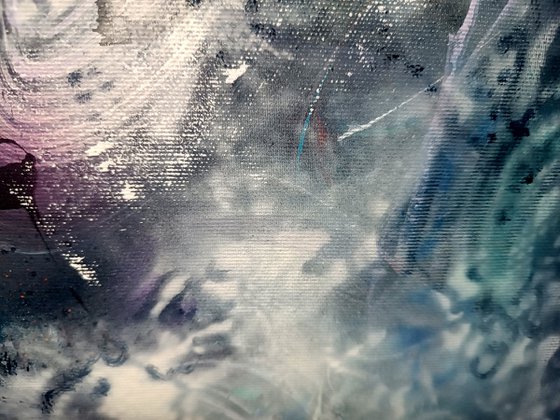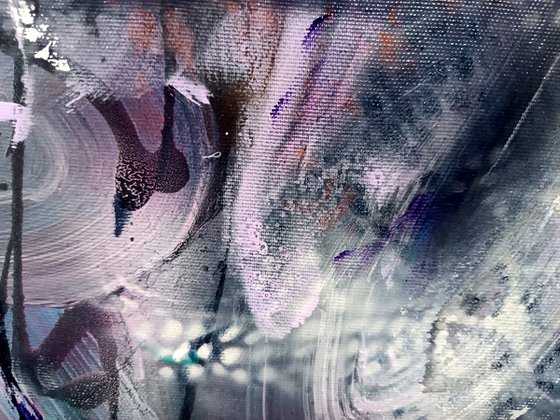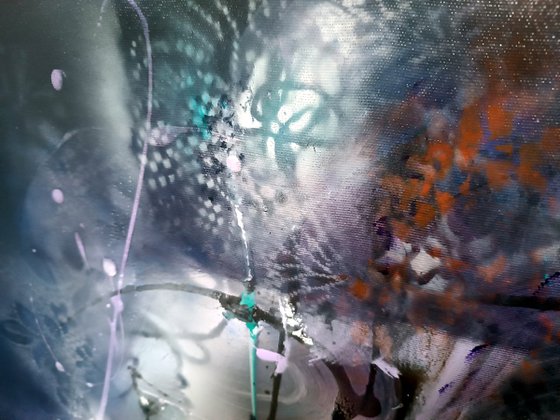Main Navigation
Original artwork description:
“Silent Genesis”
(Composition 64, from the series Between the Black and Divine, 60 x 60 cm)
In Silent Genesis, Ovidiu Kloska confronts one of the oldest and most urgent longings within the human spirit: the desire to fly—not merely through the air, but away from the weight of being, away from the mundane repetition of earthly routine. Here, flight is not about wings but about transcendence. It is a metaphysical act, a break from form into essence, from the seen into the sensed, from the material into the immaterial.
This painting becomes a metaphor for spiritual ascension, a silent detonation where matter dissolves and the soul reclaims its primordial fluidity. The swirling textures and vaporous transitions suggest a chrysalis-like rupture—a breaking of the skin of reality. The eye follows liquid paths of color, guided by instinct rather than logic, moving like thought before language. In these sinuous gestures, we feel the imprint of a consciousness straining toward the Divine, toward something that cannot be held, only felt.
The palette itself is cosmic, marked by iridescent violets, aquas, spectral silvers, and shadows deeper than memory. These are not mere colors—they are states of being, thresholds of perception. The contrasts speak not of conflict, but of longing. Light, in Kloska’s universe, is always emerging from shadow, never fully formed, always becoming—just like the soul.
From a philosophical perspective, Silent Genesis channels the Platonic yearning for the world of Forms—a reality more real than what we see. It is as if the painting tries to remember something forgotten, to retrieve the essential from the obscured. In this sense, the work resonates with the existential tension between immanence and transcendence, between our rootedness in the body and our dreaming toward the sky.
In the context of contemporary abstract painting, Silent Genesis resists the sterile, conceptual minimalism often found in modern abstraction and instead returns to the primordial. It evokes the legacy of artists like Zao Wou-Ki, Richter, or even the lyrical abstraction of Soulages, where gesture becomes invocation, and where painting is not a product but an event—an opening into something beyond.
Kloska’s abstraction is deeply personal, yet universal. It reclaims the power of painting not to represent but to reveal—not what is, but what might be, what trembles on the edge of becoming. In this way, Silent Genesis offers a space of liberation—a sanctuary where we are permitted, for a moment, to drift free from gravity, and to remember that inside us, still, lives the desire to fly beyond the flesh, toward that which is luminous, sacred, and unnamed.
Materials used:
acrylics and spray paints on canvas varnished
Tags:
#energy #genesis #light & #metaphysical art #flying desire #ovidiu kloska #chiaro scuro #vibrations art #light shadow #dark divineSilent genesis (2025) Acrylic painting
by Kloska Ovidiu
20 Artist Reviews
Now £428.02 £611.45
30% off sale. Sale ends in 10 days 3 hours
- Acrylic painting on Canvas
- One of a kind artwork
- Size: 60 x 60 x 2cm (unframed) / 60 x 60cm (actual image size)
- Ready to hang
- Signed on the front
- Style: Organic
- Subject: Abstract and non-figurative
Loading
Original artwork description
“Silent Genesis”
(Composition 64, from the series Between the Black and Divine, 60 x 60 cm)
In Silent Genesis, Ovidiu Kloska confronts one of the oldest and most urgent longings within the human spirit: the desire to fly—not merely through the air, but away from the weight of being, away from the mundane repetition of earthly routine. Here, flight is not about wings but about transcendence. It is a metaphysical act, a break from form into essence, from the seen into the sensed, from the material into the immaterial.
This painting becomes a metaphor for spiritual ascension, a silent detonation where matter dissolves and the soul reclaims its primordial fluidity. The swirling textures and vaporous transitions suggest a chrysalis-like rupture—a breaking of the skin of reality. The eye follows liquid paths of color, guided by instinct rather than logic, moving like thought before language. In these sinuous gestures, we feel the imprint of a consciousness straining toward the Divine, toward something that cannot be held, only felt.
The palette itself is cosmic, marked by iridescent violets, aquas, spectral silvers, and shadows deeper than memory. These are not mere colors—they are states of being, thresholds of perception. The contrasts speak not of conflict, but of longing. Light, in Kloska’s universe, is always emerging from shadow, never fully formed, always becoming—just like the soul.
From a philosophical perspective, Silent Genesis channels the Platonic yearning for the world of Forms—a reality more real than what we see. It is as if the painting tries to remember something forgotten, to retrieve the essential from the obscured. In this sense, the work resonates with the existential tension between immanence and transcendence, between our rootedness in the body and our dreaming toward the sky.
In the context of contemporary abstract painting, Silent Genesis resists the sterile, conceptual minimalism often found in modern abstraction and instead returns to the primordial. It evokes the legacy of artists like Zao Wou-Ki, Richter, or even the lyrical abstraction of Soulages, where gesture becomes invocation, and where painting is not a product but an event—an opening into something beyond.
Kloska’s abstraction is deeply personal, yet universal. It reclaims the power of painting not to represent but to reveal—not what is, but what might be, what trembles on the edge of becoming. In this way, Silent Genesis offers a space of liberation—a sanctuary where we are permitted, for a moment, to drift free from gravity, and to remember that inside us, still, lives the desire to fly beyond the flesh, toward that which is luminous, sacred, and unnamed.
Materials used:
acrylics and spray paints on canvas varnished
Tags:
#energy #genesis #light & #metaphysical art #flying desire #ovidiu kloska #chiaro scuro #vibrations art #light shadow #dark divine14 day money back guaranteeLearn more
